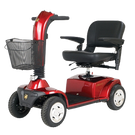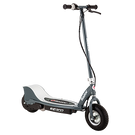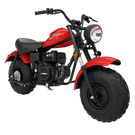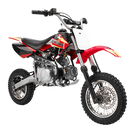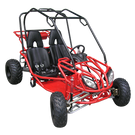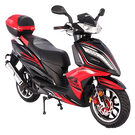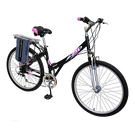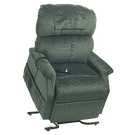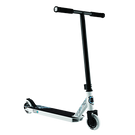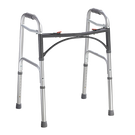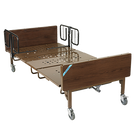How you measure for a new seat depends on whether your old seat is already a good fit for you or not. If you are just replacing a worn but otherwise correct fitting seat, then the first section below should give you a good idea of how to identify the correct dimensions before placing your order. However, if you need a seat that is larger or small, deeper or more narrow than the one already on your scooter, then please refer to the second section.
Measuring for a new seat of the same size
The illustration and following guideline is courtesy of our friends at Pride Mobility, the folks who make Pride and Go-Go scooters, and the Jazzy, Jet, and Quantum brands of power chairs. These clear instructions for measuring an existing seat base are applicable to just about any scooter or electric wheelchair brand or model.

Illustrations used by permission of Pride Mobility Products Corp.
NOTE: Specifications allow for a tolerance of -1/4" and +1/2". For Example a designated 18" deep seat could measure as little as 17-3/4", or as much as 18-1/2".
Measuring Usable Seat Depth-- Refer to Figures 1 and 2
1. Position a carpenter's square on the middle of the seat as shown.
2. Slide the square back until it just makes contact with the seatback. Keep the horizontal section of the square parallel with the floor. This will allow for contours such as cushioning bolsters.
3. Measure the distance between points A and C. This measurement is the seat's usable seat depth.
Measuring Usable Seat Width-- Refer to Figure 2
1. Measure 4-1/2" from point A to find line B-D.
2. Measure the distance between B and D. This measurement is the usable seat width.
You can read the full Pride Mobility Updated Guidelines for Seat Measurements in PDF form by clicking this link.
Replacing a seat with one of a different size Measuring for a proper fitting seat base "from scratch" is a quick and simple process; taking not much more time to do than the time it takes to read about it. A very accurate set of dimensions can be made with nothing more than a yardstick or tape measure and hard surface such as a table or desk to sit on. The user should sit comfortably on the table or desk in a natural posture with their knees bent and legs hanging straight down over the edge at a 90 degree angle. Mark the widest point between the hips and the knees on either side, and also mark the natural back spot. If convenient, three small items like books can be placed on either side and behind to mark where the user sits.
Seat Base Width
Add an extra one or two inches to the widest hip-to-knee measurement to get the right seat width size. A good fitting and comfortable seat means that there needs to be a little side-to-side wiggle room. Additionally, there needs to be space for bulky winter clothing, depending of course on the climate. A slightly over-wide seat base can be made snugger with a seat belt, but a seat that is too narrow benefits no one.
Seat Base Depth
As few people find it comfortable to sit with the front of a seat directly against the back of their knees, the proper scooter or power wheelchair seat should be about two inches shorter than the length between the user's back and the inside of their knees. This allows for a bit of stretching and relaxing while seated and reduces cramping and fatigue.
The quick and simple version of the above? Side-to-side measurement plus one or two inches; front-to-back measurement minus two inches. That should give you the correct measurements for a safe and comfortable seat base on any power wheelchair or mobility scooter.
Seat Back Width
The nominal width of a seat's back is always the same as that of the seat base, even though the back's true linear measurement may actually differ by an inch or more. For example; a seat back referred to as 18" may have a true measurement of only 17" across, but it is the correct size to pair with an 18" seat base. It is very important to always order the same nominal seat back depth as that of the base, and not by simply measuring the width of an existing seat back. Just as a wooden "two by four" doesn't really measure out at two inches and four inches respectively, an "18 inch seat back" refers to a back that fits a nominal 18" seat base, and not necessarily one that is itself 18" wide.
Seat Back Height
There are two general seat back heights for scooters and power chairs; the standard medium back of between 12" and 18", and the high back for users requiring more spinal support. It must be noted that different manufacturers use different measurements to determine what is meant by medium or high back, but in general, a medium back will reach the shoulder blades, and a high back will reach the top of the shoulders or higher. The high back can be any height over 16" and may include a headrest. Determining the correct height is then more of a matter of orthopedics than strict linear measurement. If a physician or physical therapist recommends the additional support, then you need a high back seat.
Summary
Unfortunately, there is no perfect "one size fits all" power chair or mobility scooter seat. An average adult, meaning someone from 5'-4" to 6' in height, and between 125 to 180 lbs. in weight, might fit quite comfortably in a nominal 18" wide by 19" deep seat. However people come in all shapes, sizes, and degrees of mobility impairment, and therefore most current manufacturers offer their popular models with several seating size options.
Many people who buy a pre-owned scooter or power chair soon find that the previous owner's seat is mismatched to their physical requirements; either uncomfortably too narrow, dangerously too wide, or too deep for their feet to reach the foot rests or platform. Additionally, many people buy a scooter or power chair for someone else, a loved one perhaps, but do not think ahead and take five minutes to properly measure and determine what the intended user's seating requirements are.
The two most important measurements when selecting a replacement power chair or mobility scooter seat are the width and depth of the seat base. Power wheelchair seat backs are usually offered in either a high or medium back version, sometimes with a headrest option. Many mobility scooters use a standard fixed height, while other models offer optional seat backs similar to those on power chairs.
The information offered above is offered as only a rough guide for selecting replacement seating components, and further details can usually be found in your scooter or power chair's owner's manual or manufacturer's website. If you are still unsure about the best seat size for your needs, please consult your physician or physical therapist for more detailed advice.

